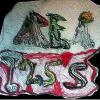Does anyone have experience taking Jujube they can share? I'm interested in trying it as an anxiolytic.
Jujube is included in a variety of supplements with names like "Seditol", "Chamomile Sleep", "Calm Child", "Positive Teens & Kids", "CalmEZ", "Chi'll Out". Swanson sells a Jujube extract that they advertise is for anxiety and stress. But, most of the reviews at Swanson are about sleep.
I would guess it acts on GABA receptors. I'm worried about tolerance and down regulating my GABA receptors. This study is one I found that mentions GABA:
J Ethnopharmacol. 2009 Jul 30;124(3):421-5.
Interactions of Magnolia and Ziziphus extracts with selected central nervous system receptors.
Koetter U, Barrett M, Lacher S, Abdelrahman A, Dolnick D.
Dr. Koetter Consulting, Kirchhalde 19, Uttwil 8592, Switzerland.
Magnolia officinalis Rehder and Wilson [Magnoliaceae] bark and Ziziphus spinosa (Buhge) Hu ex. Chen. [Fam. Rhamnaceae] seed have a history of use in traditional Asian medicine for mild anxiety, nervousness and sleep-related problems. To identify pharmacological targets, extracts of Magnolia officinalis (ME), Ziziphus spinosa (ZE), and a proprietary fixed combination (MZE) were tested for affinity with central nervous system receptors associated with relaxation and sleep. In vitro radioligand binding and cellular functional assays were conducted on: adenosine A(1), dopamine (transporter, D(1), D(2S), D(3), D(4.4) and D(5)), serotonin (transporter, 5-HT(1A), 5-HT(1B), 5-HT(4e), 5-HT(6) and 5-HT(7)) and the GABA benzodiazepine receptor. Interactions were demonstrated with the adenosine A(1) receptor, dopamine transporter and dopamine D(5) receptor (antagonist activity), serotonin receptors (5-HT(1B) and 5-HT(6) antagonist activity) and the GABA benzodiazepine receptor at a concentration of 100 microg/ml or lower. ME had an affinity with adenosine A(1) (K(i) of 9.2+/-1.1 microg/ml) and potentiated the GABA activated chloride current at the benzodiazepine subunits of the GABA receptor (maximum effect at 50 microg/ml). ME had a modest antagonist action with 5-HT(6) and ZE with the 5-HT(1B) receptor. The interactions in the receptor binding models are consistent with the traditional anxiolytic and sleep-inducing activities of Magnolia officinalis bark and Ziziphus spinosa seed.
PMID: 19505549
It appears to inhibit NMDA:
J Ethnopharmacol. 2004 Nov;95(1):39-45.
Protection of NMDA-induced neuronal cell damage by methanol extract of zizyphi spinosi semen in cultured rat cerebellar granule cells.
College of Veterinary Medicine and Research Institute of Veterinary Medicine, Chungbuk National University, Cheongju, South Korea.
Zizypus is one of the herbs widely used in Korea and China due to the CNS calming effect. The present study aims to investigate the effect of the methanol extract of Zizyphi Spinosi Semen (ZSS), the seeds of Zizyphus jujuba Mill var. spinosa, on N-methyl-D-aspartate (NMDA)-induced neurotoxicity in cultured rat cerebellar granule neuron. ZSS, over a concentration range of 0.05-5 microg/ml, inhibited NMDA (1 mM)-induced neuronal cell death, which was measured by a trypan blue exclusion test and a 3-[4,5-dimethylthiazol-2-yl]-2,5-diphenyl-tetrazolium bromide (MTT) assay. ZSS (0.5 microg/ml) inhibited glutamate release into medium induced by NMDA (1mM), which was measured by HPLC. Pretreatment of ZSS (0.5 microg/ml) inhibited NMDA (1mM)-induced elevation of cytosolic calcium concentration ([Ca(2+)]©), which was measured by a fluorescent dye, Fura 2-AM, and generation of reactive oxygen species (ROS). These results suggest that ZSS prevents NMDA-induced neuronal cell damage in vitro.
PMID: 15374605
Biol Pharm Bull. 2008 Sep;31(9):1749-54.
Protective effects of sanjoinine A against N-methyl-D-aspartate-induced seizure.
Research Institute of Veterinary Medicine, Chungbuk National University, Cheongju, South Korea.
Sanjoinine A is a component of the alkaloid fraction of Zizyphi Spinosi Semen. This experiment was performed to investigate whether sanjoinine A acts as an anticonvulsive in the N-methyl-D-aspartate (NMDA)-induced experimental seizure model. We also examined whether it protects against seizure-form electroencephalogram (EEG) alterations induced by NMDA in vivo and/or cell killing due to NMDA in cultured cerebellar granule cells. Administration of sanjoinine A increased the survival rate and the latency of seizure onset, and decreased the seizure scores and the weight-loss induced by NMDA in mice, in a dose-dependent manner. In addition, sanjoinine A blocked seizure-form EEG alterations induced by NMDA and inhibited NMDA-induced cell killing in cultured rat cerebellar granule cells, measured by both the trypan blue exclusion test and the 3-[4,5-dimethylthiazol-2-yl]-2,5-diphenyltetrazolium bromide (MTT) assay. Moreover, sanjoinine A inhibited the elevation of intracellular calcium influx induced by NMDA, which was measured using a fluorescent dye, Furo 3-AM. It is suggested that sanjoinine A protects against NMDA-induced seizures by inhibiting intracellular calcium influx.
PMID: 18758071
Wikipedia mentions nootropic and neuroprotective properties with these references:
18. Taati, Majid; Masoud Alirezaei, Mohamad Hadi Moshkatalsadat, Bahram Rasoulian, Mehrnoush Moghadasi, Farzam Sheikhzadeh, Ali Sokhtezari. (2011). "Protective effects of Ziziphus jujuba fruit extract against ethanol-induced hippocampal oxidative stress and spatial memory impairment in rats". Journal of Medicinal Plants Research 5 (6): 915–921.
19. Yoo, Ki-Yeon; Hua Li, In Koo Hwang, Jung Hoon Choi, Choong Hyun Lee, Dae Young Kwon, Shi Yong Ryu, Young Sup Kim, Il-Jun Kang, Hyung-Cheul Shin, and Moo-Ho Won. (2010). "Zizyphus Attenuates Ischemic Damage in the Gerbil Hippocampus via Its Antioxidant Effect". Journal of Medicinal Food 13 (3): 557–563. doi:10.1089/jmf.2009.1254.
20. Pahuja, M; Mehla J, Reeta KH, Joshi S, Gupta YK. (2011). "Hydroalcoholic extract of Zizyphus jujuba ameliorates seizures, oxidative stress, and cognitive impairment in experimental models of epilepsy in rats". Epilepsy Behav. 21 (4): 356–63.doi:10.1016/j.yebeh.2011.05.013.
21. Carson, Ralph E. (2012). The Brain Fix: What's the Matter with Your Gray Matter: Improve Your Memory ... - Google Books.ISBN 0757316298.














































